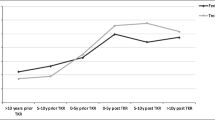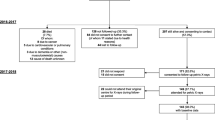Abstract
We investigated the radiological and epidemiological data of 4,151 subjects followed up from 1976 to 2003 to determine individual risk factors for hip osteoarthritis (OA), hip pain and/or treatment by total hip replacement (THR). Pelvic radiographs recorded in 1992 were assessed for evidence of hip-joint degeneration and dysplasia. Sequential body mass index (BMI) measurements from 1976 to 1992, age, exposure to daily lifting and hip dysplasia were entered into logistic regression analyses. The prevalence of hip dysplasia ranged from 5.4% to 12.8% depending on the radiographical index used. Radiological hip OA prevalence was 1.0–2.5% in subjects <60 years of age and 4.4–5.3% in subjects ≥60 years of age. While radiological OA was significantly influenced by hip dysplasia in men and hip dysplasia and age in women, the risk of THR being performed was only influenced by BMI assessed in 1976. Hip-joint degeneration and treatment by THR do not necessarily share the same risk factors, and caution should be exercised in epidemiological studies in attributing one or the other as the end point of coxarthrosis.
Résumé
Nous avons enquêté sur des données radiologiques et épidémiologiques de 4.151 sujets suivi de 1976 à 2003 pour déterminer des facteurs de risque individuels d’arthrose de la hanche, de douleurs de la hanche et/ou du traitement par prothèse totale de hanche (PTH). Les radiographies pelviennes enregistrées en 1992 ont été réparties selon l’atteinte dégénérative de la hanche et la dysplasie. La valeur de l’index de masse corporelle séquentielle de 1976 à 1992, l’âge, l’activité quotidienne et la dysplasie de la hanche sont entrées dans une analyse de régression. La prédominance de la dysplasie de la hanche s’étend de 5,4% à 12,8% selon l’index radiographique utilisé. La prédominance de l’arthrose radiologique était de 1,0 à 2,5% chez les sujets de moins de 60 ans, et de 4,4 à 5,3% chez les sujets de 60 ans ou plus. Tandis que l’arthrose radiologique était significativement influencée par la dysplasie de la hanche chez les hommes, par la dysplasie et l’âge chez les femmes, le risque de réalisation d’une PTH était seulement influencé par l’index de masse corporelle mesuré en 1976. La dégénérescence de la hanche et le traitement par PTH ne partagent pas nécessairement les mêmes facteurs de risque, et la prudence dans les études épidémiologiques devrait être de nommer l’un ou l’autre comme l’événement final de la coxarthrose.

Similar content being viewed by others
References
Axmacher B, Lindberg H (1993) Coxarthrosis in farmers. Clin Orthop 82–86
Coggon D, Croft P, Kellingray S, Barrett D, McLaren M, Cooper C (2000) Occupational physical activities and osteoarthritis of the knee. Arthritis Rheum 43:1443–1449
Coggon D, Kellingray S, Inskip H, Croft P, Campbell L, Cooper C (1998) Osteoarthritis of the hip and occupational lifting. Am J Epidemiol 147:523–528
Cooper C, Inskip H, Croft P, Campbell L, Smith G, McLaren M, Coggon D (1998) Individual risk factors for hip osteoarthritis: obesity, hip injury, and physical activity. Am J Epidemiol 147:516–522
Croft P, Cooper C, Wickham C, Coggon D (1990) Defining osteoarthritis of the hip for epidemiologic studies. Am J Epidemiol 132:514–522
Danielsson LG (1964) Incidence and prognosis of coxarthrosis. Acta Orthop Scand Suppl 66:1–61
Dougados M, Gueguen A, Nguyen M, Berdah L, Lequesne M, Mazieres B, Vignon E (1996) Radiological progression of hip osteoarthritis: definition, risk factors and correlations with clinical status. Ann Rheum Dis 55:356–362
Dougados M, Gueguen A, Nguyen M, Berdah L, Lequesne M, Mazieres B, Vignon E (1997) Radiographic features predictive of radiographic progression of hip osteoarthritis. Rev Rhum Br 64:795–803
Dougados M, Gueguen A, Nguyen M, Berdah L, Lequesne M, Mazieres B, Vignon E (1999) Requirement for total hip arthroplasty: an outcome measure of hip osteoarthritis? J Rheumatol 26:855–861
Hansson G, Jerre R, Sanders SM, Wallin J (1993) Radiographic assessment of coxarthrosis following slipped capital femoral epiphysis. A 32-year follow-up study of 151 hips. Acta Radiol 34:117–123
Heyman CH, Herndon CH (1950) Legg–Perthes disease. A method for the measurement of the roentgenographic result. J Bone Joint Surg Am 32:767–778
Jacobsen S, Sonne-Holm S, Lund B, Søballe K, Kiær T, Rovsing H, Monrad H (2004) Pelvic orientation and assessment of hip dysplasia in adults. Acta Orthop Scand 75:721–730
Jacobsen S, Sonne-Holm S, Søballe K, Gebuhr P, Lund B (2005) Joint space width in hip dysplasia. J Bone Joint Surg Br Accepted for publication
Jacobsen S, Sonne-Holm S, Soballe K, Gebuhr P, Lund B (2004) Factors influencing hip joint space in asymptomatic subjects. Osteoarthr Cartil 12:698–703
Jacobsen S, Sonne-Holm S, Soballe K, Gebuhr P, Lund B (2004) The distribution and inter-relationships of radiologic features of osteoarthrosis of the hip. Osteoarthr Cartil 12:704–710
Kellgren JH, Lawrence JS (1957) Radiological assessment of osteo-arthritis. Ann Rheum Dis 16:494–502
Lanyon P, Muir K, Doherty S, Doherty M (2003) Age and sex differences in hip joint space among asymptomatic subjects without structural change: implications for epidemiologic studies. Arthritis Rheum 48:1041–1046
Lievense AM, Bierma-Zeinstra SM, Verhagen AP, van Baar ME, Verhaar JA, Koes BW (2002) Influence of obesity on the development of osteoarthritis of the hip: a systematic review. Rheumatology 41:1155–1162
Marks R, Allegrante JP (2002) Body mass indices in patients with disabling hip osteoarthritis. Arthritis Res 4:112–116
Smith RW, Egger P, Coggon D, Cawley MI, Cooper C (1995) Osteoarthritis of the hip joint and acetabular dysplasia in women. Ann Rheum Dis 54:179–181
Tepper S, Hochberg MC (1993) Factors associated with hip osteoarthritis: data from the First National Health and Nutrition Examination Survey (NHANES-I). Am J Epidemiol 137:1081–1088
Tonnis D (1976) Normal values of the hip joint for the evaluation of X-rays in children and adults. Clin Ortop 119:39–47
Vingård, E (1991) Overweight predisposes to coxarthrosis. Acta Orthop Scand 62:106–109
Wiberg G (1939) Studies on dysplastic acetabula and congenital subluxation of the hip joint. Acta Orthop Scand Suppl 58:1–132, (Stockholm; P.A. Norstedt & Söner)
Author information
Authors and Affiliations
Corresponding author
Rights and permissions
About this article
Cite this article
Jacobsen, S., Sonne-Holm, S. Increased body mass index is a predisposition for treatment by total hip replacement. International Orthopaedics (SICOT) 29, 229–234 (2005). https://doi.org/10.1007/s00264-005-0658-2
Received:
Revised:
Accepted:
Published:
Issue Date:
DOI: https://doi.org/10.1007/s00264-005-0658-2




